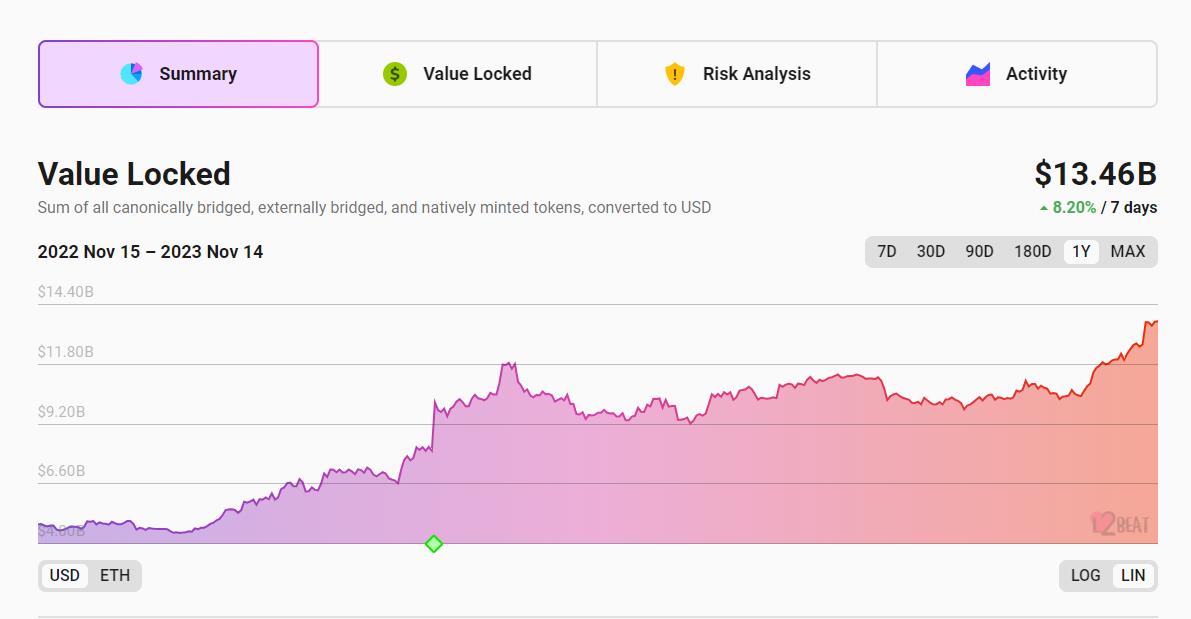
Growing Interest in Layer 2 Networks
Ethereum Layer 2 networks have hit a major milestone, with a total value locked (TVL) of $13 billion within their contracts, according to data from blockchain analytics platform L2Beat. This surge in interest is expected to continue, although there are still challenges to overcome, particularly in terms of user experience and security.
The Rise of Layer 2 TVL
As reported by L2Beat, there are currently 32 different networks that qualify as Ethereum layer 2s, including popular ones like Arbitrum One, Optimism, Base, Polygon zkEVM, and Metis. Before June 15, these networks had a combined TVL of less than $10 billion, which had been declining since reaching a peak of $11.8 billion in April. However, since June 15, layer 2 TVL has shown positive growth, reaching a new high of nearly $12 billion by October 31. The investment in layer 2 apps has continued to climb, surpassing the $13 billion TVL mark on November 10 and currently standing at nearly $13.5 billion.
Comparing TVL Growth
The rise in layer 2 TVL is even more impressive when compared to the growth rate during the bull market of 2021. Despite the overall cryptocurrency market cap being smaller now than it was during the bull market, layer 2s had less than $6 billion locked within their contracts on November 12, 2021, when the market cap reached an all-time high of $2.82 trillion. Currently, with a more modest market cap of $1.4 trillion, layer 2 TVL is greater than ever.
The Impact of High Gas Fees
According to Metis CEO Elena Sinelnikova, the high gas fees on Ethereum during the bull market left a lasting impact on users, leading to a desire for alternatives when demand started to rebound. Sinelnikova explained that Ethereum was not scalable during peak times, resulting in slow and expensive transactions. This unsustainable situation prompted users to seek out layer 2 solutions.

Marketing Efforts and User Activity
Sinelnikova also pointed out that layer 2 networks have thrived in the bear market due to the successful marketing efforts of their development teams. This has attracted high user activity and resulted in high yields. She stated that these networks are deploying capital to attract new users and businesses into decentralized finance (DeFi), as DeFi participants are always drawn to high yields.
Challenges in User Experience
Despite the growth and success of layer 2 networks, they still face challenges in terms of user experience. For example, optimistic rollup networks require users to wait 7 days for a withdrawal to be processed, which can be frustrating. On the other hand, newer zero-knowledge (ZK) proof networks can process withdrawals instantly but are still in the early stages of development and tend to crash more frequently. To address these issues, Metis is working on a "hybrid" layer 2 network that combines the best features of both types, giving users the option to withdraw using either an instant ZK prover or a 7-day optimistic process.
Concerns About Centralization
Kelsey McGuire, the chief growth officer for layer 1 network Shardeum, highlighted another challenge faced by layer 2 networks: centralization. While these networks offer scalability enhancements, they often introduce a trade-off in decentralization. McGuire expressed concerns about potential censorship or government interference due to the use of centralized sequencer nodes in layer 2 implementations. This centralized aspect challenges the core principles of decentralization and trustlessness that are fundamental to the blockchain space.
Competition Driving Improvements
McGuire believes that the competition from layer 2 networks will drive improvements to layer 1 networks, leading to higher throughput for the foundational layers themselves. She predicts that there will be a refocus on true scalability at the foundational layer, with high transactions per second (TPS) and low gas fees, instead of relying solely on layer 2s for scalability.
The Growing Number of Layer 2s
In addition to the increase in TVL, the number of layer 2 networks continues to rise. Crypto exchange OKX recently announced its plans to build a layer 2 network, and there are rumors that Kraken is also developing one.






